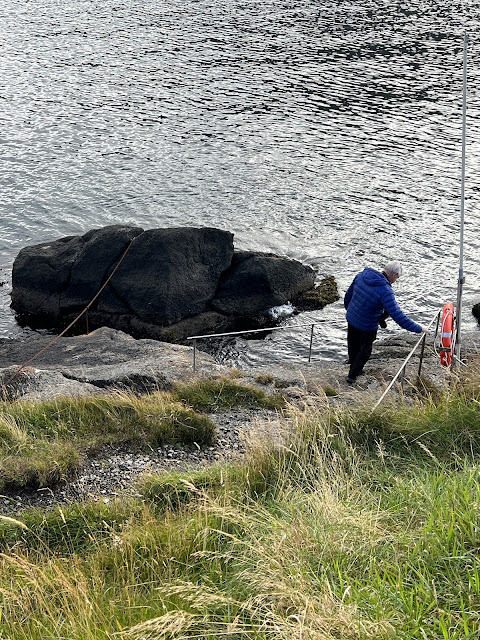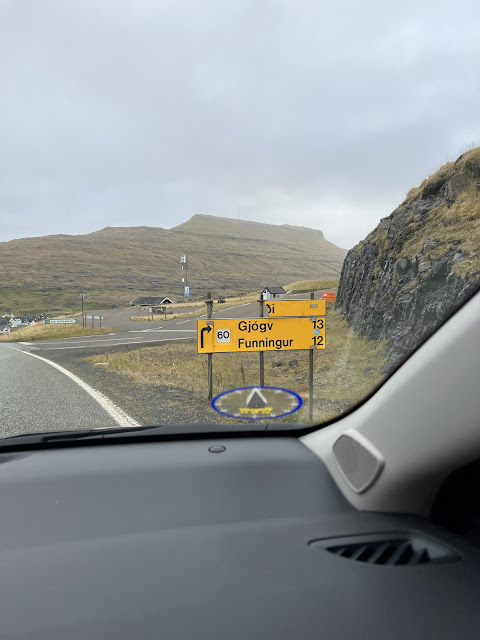 |
Part of our route today with side trip to Tjørnuvík (left). Those mountain symbols indicate precipitous cliffs.
|
Today we were to explore a little more of Eysturoy (East Island) which, after Streymoy, is the largest in size and population and is home to some of the tallest mountains of the Faroes Islands. We spent a little time exploring the wee village of Gjogv before heading back up the mountain to THAT ‘road’, that precipitous switch-back road straight down the massive Slaettaratnyindur mountain, birthplace of one of the many humongous glaciers of the last ice age.
 |
| Very quaint |
 |
| Fish drying at the back of one house |
 |
| A boat slip where they would haul their boats away from notoriously high seas |
We were heading for Funningur which people say has been inhabited since the ‘land taking’ period, i.e. the Norse invasion. In the book “Føroyinga søga” (The story of the Faroese) it is told that the ‘settlement period’ or the ‘landnam’ – land taking by the Norse – took place in Funningur, and that the settlement got its name from the fact that land was ‘found’. The first named person to set foot on the islands was Grímur Kamban, who came here in about the year 825. His first name Grímur is a Norse name, while Kamban is Celtic and means ‘the lame one’. This indicates, what science later confirmed with various genetic tests, that the Faroese and Icelanders are as much of Celtic as of Norse origin—especially the women.
People have lived in Funningur since ‘land taking’ period.
Funningur is a rather beautiful, hidden hamlet crouched by the peaceful open Funning fjord and surrounded by the island’s highest mountain. It is a typical Faroese village where clusters of houses cling to the mountain sides close to the coast on either side of a fresh water stream and surrounded by rich grasslands. Funningur was a perfect find for the Vikings - it had easy access to sea fishing, good farming opportunities and lots of fresh water. An ideal place to settle down with families and cultivate new land.
 |
| Everyone plays chicken with the sheep but the sheep always win |
 |
| The road over the mountains which we travelled yesterday is closed autumn through winter |
 |
| The Funning fjord is wide and deep |
 |
| A side road to a farm over the hill |
 |
| Funningur nestles at the mouth of a stream that rockets down the mountain |
 |
| A small statute to Grímur Kamban on the other side is a Viking vessel |
We headed further around the headland along the Funning fjord to Elduvik on the other side of the fjord but we took a detour to Oyndarfjordur which has some rather startling rocks – the
Rocking Stones (Rinkusteinar). According to legend they were once pirate ships threatening the village and a local witch turned them into the restless stones we saw today – they rock as the sea rises and falls.

 |
| Fish farms everywhere - mostly salmon |
 |
| The location of the Rocking Stones |
 |
| Many attractions had QR codes so you could read the stories |
 |
| Lindsay walked down to the waters edge but I chose to enjoy from a distance |
 |
| These two large rocking stones are chained to the shore lest they rock off! |
We then headed north to Eidi which sits aside a narrow flat isthmus. We drove out as far as the road allowed and had a picnic with spectacular views. We were there to see the
Risin og Kellingin - the Giant and the Witch .... another wonderful legend/saga. “Once upon a time an Icelandic chief witch sent a giant and his witch wife to the Faroes to steal the islands and bring them back to Iceland …… They toiled all night long and were so preoccupied that they failed the notice the first beams of sunlight appearing on the horizon. Inevitably they turned to stone and have remained there even since staring westward to their home.”
 |
| They're everywhere! |
 |
| We were heading into that fjord to get a better look back at the 'Witch and the Giant' which was back back behind us! |
 |
| ....but first we had to get onto the other island - Streymoy |
 |
| And yes another precipitous narrow road |
 |
| That's Tjørnuvík nestled down there. So picturesque. |
We couldn’t see the rock formations from where we were and didn’t fancy an extremely long walk so settled for a long somewhat scary ride instead to the village of Tjørnuvík which is on the island of Streymoy – we do these things! It was a longish drive and as we approached the northern tip of the island the roads were steep and clinging to the mountainside. We hopped out of the car at one safe place for viewing but Lindsay said let’s go further. I was questioning our sanity but when we finally arrived in the sleepy village of Tjørnuvík I was glad we came. Tjornuvík is among the oldest villages in the Faroe Islands, Viking graves have been found in the eastern part of the valley. It is a place of mysterious creatures.
 |
| Surfing is very popular here in summer |

In fact the whole of the Faroes has a magical faerie-like quality. In the village of Tjørnuvík, there are whispers of the mysterious Huldufolk which dwell among the hills and mounds, unseen yet ever-present. Towering in stature, some reaching a staggering three metres tall, these elusive beings cover themselves in shades of grey, their presence as ethereal as the mist that cloaks the landscape. Rarely seen by mortal eyes, the Huldufolk move among the people, tending to the land and its creatures with a mystical grace. Huldufólk, or hidden people, are elves in Icelandic and Faroese folklore. They are supernatural beings that look and behave similarly to humans but live in a parallel world. Masters of illusion, they can veil themselves and their belongings from human sight, constructing enchantments that bewilder the innocent. Believe it or not …… We spoke with the woman who managed one of the B&Bs we stayed in and she, although not a believer, had a friend who had seen them - and she believed him?! It is so similar to what we encountered in Iceland - people ‘don’t believe’ but are a little nervous to dismiss the existence of faery-folk entirely. Stranger than fiction! I love it. On a more corporeal front, this little village attracts surfers from far and wide and I got the sense that visitors, or at least their cars, are not allowed into the village.
Of course we had to retrace our steps and back over the mountain we had traversed yesterday but happily today it was not shrouded in rain. But mountains are unpredictable and as we drove the mist was descending so we didn't dilly dally. We made it back with just a little more ‘confidence’ in negotiating Faroes mountain roads. Our timing was fortuitous as the next day the rood would be closed for the winter. Along the road we saw some pretty enchanting scenes and also came across a roof-turf 'farm'.
A pretty wonderful day all in all.
 |
| The sheep and Greylag geese are fearless. |
 |
| Cutting turf for the roofs |
 |
| Unsurprisingly some of the waterfalls are used to generate electricity |
I am becoming overwhelmed with the Faroes. It is just so beautiful, so full of wonder and mystery and magic I can hardly keep up. The slow trip back across the mountains provided a 'calming' effect.
 |
| Our last day negotiating this mountainous road. |
 |
| Glorious in the gathering mist |











































No comments:
Post a Comment